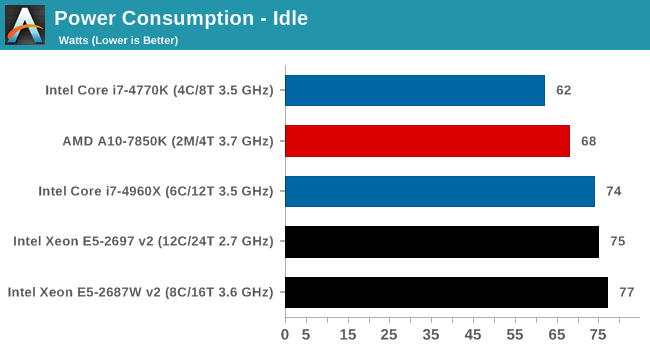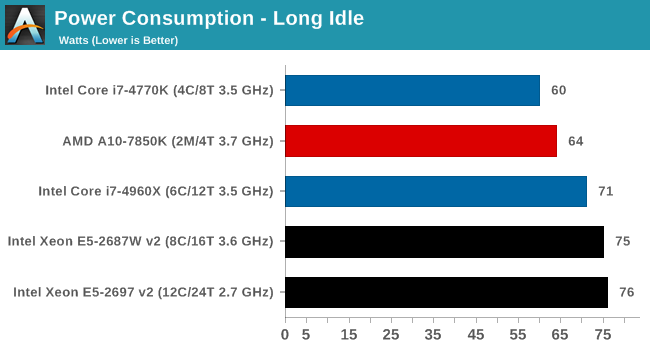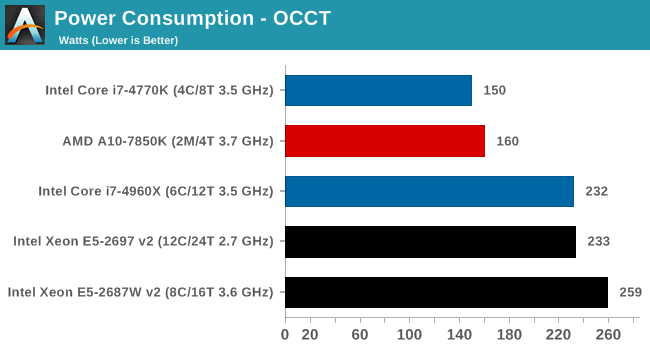Intel Xeon E5-2697 v2 and Xeon E5-2687W v2 Review: 12 and 8 Cores
by Ian Cutress on March 17, 2014 11:59 AM EST- Posted in
- CPUs
- Intel
- Xeon
- Enterprise
The Mac Pro (Late 2013)
When Anand reviewed the Mac Pro late last year, he received the full fat 12 core edition, using the E5-2697 v2 CPU with a 2.7 GHz rating. The CPU choices for the Mac Pro include 4, 6 and 8 core models, all with HyperThreading. Interestingly enough, the 4/6/8 core models all come from the E5-16xx line, meaning the CPUs are designed with single processor systems in mind. But to get to the 12 core/24 thread model at the high end, Apple used the E5-2697 v2, a processor optimized for dual CPU situations. Based on the die shots on the previous page, this has repercussions, but as Anand pointed out, it all comes down to power usage and turbo performance.
| Mac Pro (Late 2013) CPU Options | ||||||
| Intel CPU | E5-1620 v2 | E5-1650 v2 | E5-1680 v2 | E5-2697 v2 | ||
| Cores / Threads | 4 / 8 | 6 / 12 | 8 / 16 | 12 / 24 | ||
| CPU Base Clock | 3.7GHz | 3.5GHz | 3.0GHz | 2.7GHz | ||
| Max Turbo (1C) | 3.9GHz | 3.9GHz | 3.9GHz | 3.5GHz | ||
| L3 Cache | 10MB | 12MB | 25MB | 30MB | ||
| TDP | 130W | 130W | 130W | 130W | ||
| Intel SRP | $294 | $583 | ? | $2614 | ||
The Mac Pro is designed within a peak 450W envelope, and Intel has options with its CPUs. For the same TDP limit, Intel can create many cores as low frequency, or fewer cores at higher frequency. This is seen in the options on the Mac Pro – all the CPU choices have the same 130W TDP, but the CPU base clocks change as we rise up the core count. Moving from 4 cores to 8 cores keeps the maximum turbo (single core performance) at 3.9 GHz, but the base clock decreases the more cores are available. Finally at the 12-core model, the base frequency is at its lowest of the set, as well as the maximum turbo.
This has repercussions on workloads, especially for workstations. For the most part, the types of applications used on workstations are highly professional, and have big budgets with plenty of engineers designed to extract performance. That should bode well for the systems with more cores, despite the frequency per core being lower. However, it is not always that simple – the mathematics for the problem has to be able to take advantage of parallel computing. Simple programs run solely on one core because that is the easiest to develop, but if the mathematics wholly linear, then even enterprise software is restricted. This would lend a positive note to the higher turbo frequency CPUs. Intel attempts to keep the turbo frequency similar as long as it can while retaining the maximum TDP to avoid this issue; however at the 12-core model this is not possible. Quantifying your workload before making a purchase is a key area that users have to consider.
Benchmark Configuration
I talk about the Mac Pro a little because the processors we have for a ‘regular’ test today are 8-core and 12-core models. The 12-core is the same model that Anand tested in the Mac Pro – the Xeon E5-2697v2. The 8-core model we are testing today is different to the one offered in the Mac Pro, in terms of frequency and TDP:
| Intel SKU Comparison | |||
| Core i7-4960X | Xeon E5-2687W v2 | Xeon E5-2697 v2 | |
| Release Date | September 10, 2013 | September 10, 2013 | September 10, 2013 |
| Cores | 6 | 8 | 12 |
| Threads | 12 | 16 | 24 |
| Base Frequency | 3600 | 3400 | 2700 |
| Turbo Frequency | 4000 | 4000 | 3500 |
| L3 Cache | 15 MB | 25 MB | 30 MB |
| Max TDP | 130 W | 150 W | 130 W |
| Max Memory Size | 64 GB | 256 GB | 768 GB |
| Memory Channels | 4 | 4 | 4 |
| Memory Frequency | DDR3-1866 | DDR3-1866 | DDR3-1866 |
| PCIe Revision | 3.0 | 3.0 | 3.0 |
| PCIe Lanes | 40 | 40 | 40 |
| Multi-Processor | 1P | 2P | 2P |
| VT-x | Yes | Yes | Yes |
| VT-d | Yes | Yes | Yes |
| vPro | No | Yes | Yes |
| Memory Bandwidth | 59.7 GB/s | 59.7 GB/s | 59.7 GB/s |
| Price | $1059 | $2112 | $2618 |
The reason for this review is to put these enterprise class processors through the normal (rather than server) benchmarks I run at AnandTech for processors. Before I started writing about technology, as an enthusiast, it was always interesting to hear of the faster Xeons and how much that actually made a difference to my normal computing. I luckily have that opportunity and would like to share it with our readers.
The system set up is as follows:
| Test Setup | |
| Motherboards |
GIGABYTE GA-6PXSV3 MSI X79A-GD45 Plus for 3x GPU Configurations |
| Memory | 8x4 GB Kingston DDR3-1600 11-11-11 ECC |
| Storage | OCZ Vertex 3 256 GB |
| Power Supply | OCZ 1250 ZX Series |
| CPU Cooler | Corsair H80i |
| NVIDIA GPU | MSI GTX 770 Lightning 2GB |
| AMD GPU | ASUS HD 7970 3GB |
Many thanks to...
We must thank the following companies for kindly providing hardware for our test bed:
Thank you to GIGABYTE Server for providing us with the Motherboard and CPUs
Thank you to OCZ for providing us with 1250W Gold Power Supplies and SSDs.
Thank you to Kingston for the ECC Memory kit
Thank you to ASUS for providing us with the AMD HD7970 GPUs and some IO Testing kit.
Thank you to MSI for providing us with the NVIDIA GTX 770 Lightning GPUs.
Power Consumption
Power consumption was tested on the system as a whole with a wall meter connected to the OCZ 1250W power supply, while in a single MSI GTX 770 Lightning GPU configuration. This power supply is Gold rated, and as I am in the UK on a 230-240 V supply, leads to ~75% efficiency > 50W, and 90%+ efficiency at 250W, which is suitable for both idle and multi-GPU loading. This method of power reading allows us to compare the power management of the UEFI and the board to supply components with power under load, and includes typical PSU losses due to efficiency. These are the real world values that consumers may expect from a typical system (minus the monitor) using this motherboard.
While this method for power measurement may not be ideal, and you feel these numbers are not representative due to the high wattage power supply being used (we use the same PSU to remain consistent over a series of reviews, and the fact that some boards on our test bed get tested with three or four high powered GPUs), the important point to take away is the relationship between the numbers. These boards are all under the same conditions, and thus the differences between them should be easy to spot.



At idle, the Xeons are on par with the Core i7-4960X for power consumption in the GIGABYTE motherboard. At load the extra TDP of the E5-2687W v2 can be seen.
DPC Latency
Deferred Procedure Call latency is a way in which Windows handles interrupt servicing. In order to wait for a processor to acknowledge the request, the system will queue all interrupt requests by priority. Critical interrupts will be handled as soon as possible, whereas lesser priority requests, such as audio, will be further down the line. So if the audio device requires data, it will have to wait until the request is processed before the buffer is filled. If the device drivers of higher priority components in a system are poorly implemented, this can cause delays in request scheduling and process time, resulting in an empty audio buffer – this leads to characteristic audible pauses, pops and clicks. Having a bigger buffer and correctly implemented system drivers obviously helps in this regard. The DPC latency checker measures how much time is processing DPCs from driver invocation – the lower the value will result in better audio transfer at smaller buffer sizes. Results are measured in microseconds and taken as the peak latency while cycling through a series of short HD videos - less than 500 microseconds usually gets the green light, but the lower the better.

The DPC latency of the Xeons is closer to the 100 mark, which we saw during Sandy Bridge. Newer systems seem to be increasing the DPC latency - so far all Haswell consumer CPUs are at the 140+ line.










71 Comments
View All Comments
SirKnobsworth - Monday, March 17, 2014 - link
The LGA 2011 i7 chips don't have integrated graphics.Voldenuit - Monday, March 17, 2014 - link
Yeah, the Xeon E3s are great processors for enthusiasts/consumers.I was tossing up between an E3-1230 v3 (2MB more cache) or an i5 4670K (IGP, unlocked multiplier) in my latest build, and ended up with the 4670K because it had a $30 instant rebate, and I wanted quicksync (I know Ganesh says it has inferior transcode quality to x264, but I just need something quick and dirty for my phone, and honestly, I'm seeing more artefacts in the x264 samples he posted than in the QS samples). But it wasn't an easy decision.
Minor nitpick: you can get Xeon E3s with Intel HD graphics. Those are model numbers E3-12x5
http://ark.intel.com/products/family/78581/Intel-X...
mazzy - Monday, March 17, 2014 - link
Even more if you think about the facts that E3 xeons are i7 at i5 price... with ECC and VT tech... ok no OC...MrSpadge - Tuesday, March 18, 2014 - link
I'd take a CPU with IGP any day, unless it costs significantly more. Reason: increased resale value, even if I don't use the IGP myself.CrazyElf - Tuesday, March 18, 2014 - link
"I'd take a CPU with IGP any day, unless it costs significantly more. Reason: increased resale value, even if I don't use the IGP myself."I would not.
Reason is even when you use discrete, it uses additional power. IIRC for Sandy Bridge, a 3.6 GHz Sandy without the IGP switched on uses as much as a 3.4 GHz with the IGP on. Seeing that the graphics have become a bigger emphasis with Haswell, I expect that the IGP will be using a bigger percentage of the total power consumption with time.
austinsguitar - Monday, March 17, 2014 - link
okay...please tell me im not the only one who thinks this article is hilarious! look...if you are going to review two very expensive cpu's, don't test these against normal cpu's. It is shear idiocy to compare these to "desktop cpu's" because they are not....at all. Why can't anandtech do reviews on other affordable xeons and compare them all together. Also funny how they included AMD. That's cutejemima puddle-duck - Monday, March 17, 2014 - link
It's spelt 'sheer'. That aside, your ideas are intriguing to me, and I wish to subscribe to your newsletter.PEJUman - Monday, March 17, 2014 - link
you're the only one who think this article is hilarious.I thought/wished about this dataset previously. What if we simply go to XEONs and trade off clock for cores. i.e. the next logical progression from i7-4960X price bracket. obviously with no control over turbo bins & OC capability, the single thread is hosed. But wondered how many cores near-pro programs can really utilize.
I am just glad we get to see some comparisons. getting more XEON dataset would be interesting but I think it's beyond most of Anandtech reader usage partern.
austinsguitar - Monday, March 17, 2014 - link
You do indeed have a point about consumer cpu's and how they can overclock and are nifty to have for changing multiple options. but...the xeon market for average consumers needs to either be booming or a well kept secret. the 1230v3 is a fantastic cpu and can (for the most part) equal a 4770 for 240 dollars. I know it can not be overclocked, but people (about 70% of the market) do not give a care.But anandtech viewers are overly intelligent arnt we?
MrSpadge - Tuesday, March 18, 2014 - link
Had they not included these regular CPUs people would (rightfully) complain "what do these numbers mean without familiar comparison points?" Comparing 2 products to work out the real-world differences for some specific application is completely different from claiming they'd be equal.